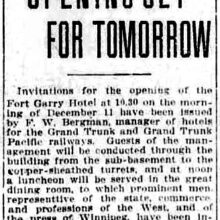Winnipeg – Fort Garry Hotel
The Fort Garry Hotel may be the closest thing Winnipeg has to a castle.
Built in 1913, the Fort Garry Hotel was designed in the uniquely Canadian Chateau style. Taking inspiration from the French Renaissance and French country homes, this elaborate style was the preferred choice for railway hotels across Canada.
Rail tourism across the country had grown significantly through the early 20th century – and companies were capitalizing on this fact. Built between 1907 and 1914, the Grand Trunk Railway ran from Winnipeg to British Columbia. Together with the Eastern Canadian Transcontinental Line, could take Canadians across Canada and then back again. The Canadian Pacific Railway shared this strategy, and their president William van Horne would remark: “If we can’t export the scenery, we’ll import the tourists.”
Encouraging railway travel further was the railway hotel: stylish hotels built near rail stations that provided upscale places for tourists to stay on their trips. The Fort Garry Hotel was part of this system, and opened in 1913 for the Grand Trunk Railway. Montreal architect’s George A. Ross and David H MacFarlane based the design for the Fort Garry hotel on Chateau Laurier in Ottawa.
In the early stages of planning, the hotel was going to be called the Selkirk, but the name was changed due to the hotel’s proximity to the former Upper Fort Garry. The Fort Garry Hotel stands near the location of this old fort, near the junction of the Red and Assiniboine Rivers and between Fort and Garry Streets.
The hotel was built four storeys taller than originally planned, with Indiana buff limestone walls that were characteristic of other Grand Trunk Pacific Railway buildings. The building’s façade is clad in ornamental stonework, and is capped by a dramatic copper roof. Influenced by the gothic style, the steeply pitched roof and turrets were considered well adapted to the northern climate. The interior was similarly grand, and had been finished with marble, bronze, oak, stained glass, gold trim, and crystal chandeliers.
The hotel’s stylish accommodations have made it a mainstay for the rich and famous coming through Winnipeg. Movie stars, musicians, and royalty have all taken advantage of the Fort Garry’s amenities. Of all the suites in the hotel, though, none have garnered more attention than Room 202. Rumours of ghosts haunting the suite have long captured the public imagination, and stories report a mysterious woman in white wandering the halls and watching over guests sleeping in Room 202. Though unproven, the hauntings are allegedly tied to an ill-fated honeymoon trip sometime in the 1910s. The unnamed couple was staying in suite 202 when the husband was killed in a car accident and the woman upon hearing the news was overcome by grief, and ultimately fell victim to suicide.
In 1920, the Grand Trunk Railway was absorbed into Canadian National Railway, and in 1979 the Fort Garry Hotel was purchased and turned into an independent hotel. It was designated a National Historic Site in 1981. Steady renovations had been done on the building, until it was expropriated by the city for non-payment of back taxes in 1987. The building is now privately owned, and it remains a luxurious destination for travellers near and far thanks to the efforts of the heritage-sympathetic owners. In 2001, it was a winner at Heritage Winnipeg’s Annual Preservation Awards for the exemplary conservation work on the 7th floor. Conservation efforts continue to this day, and the Fort Garry Hotel remains a subject of fascination for all who pass through.











 Hotel Fort Garry interior panorama
Hotel Fort Garry interior panorama